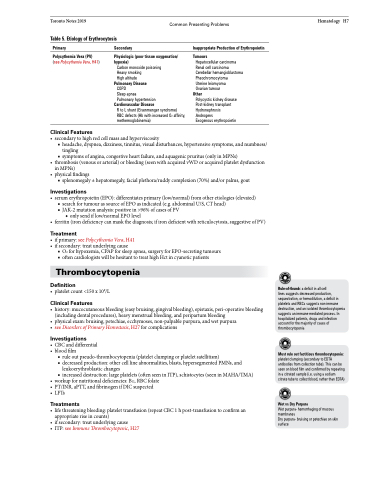Page 547 - TNFlipTest
P. 547
Toronto Notes 2019 Common Presenting Problems Table 5. Etiology of Erythrocytosis
Hematology H7
Primary
Polycythemia Vera (PV)
(see Polycythemia Vera, H41)
Clinical Features
Secondary
Physiologic (poor tissue oxygenation/ hypoxia)
Carbon monoxide poisoning Heavy smoking
High altitude
Pulmonary Disease
COPD
Sleep apnea
Pulmonary hypertension
Cardiovascular Disease
R to L shunt (Eisenmenger syndrome) RBC defects (Hb with increased O2 affinity, methemoglobinemia)
Inappropriate Production of Erythropoietin
Tumours
Hepatocellular carcinoma Renal cell carcinoma Cerebellar hemangioblastoma Pheochromocytoma
Uterine leiomyoma
Ovarian tumour
Other
Polycystic kidney disease Post-kidney transplant Hydronephrosis Androgens
Exogenous erythropoietin
• secondarytohighredcellmassandhyperviscosity
■ headache, dyspnea, dizziness, tinnitus, visual disturbances, hypertensive symptoms, and numbness/
tingling
■ symptoms of angina, congestive heart failure, and aquagenic pruritus (only in MPNs)
• thrombosis(venousorarterial)orbleeding(seenwithacquiredvWDoracquiredplateletdysfunction in MPNs)
• physicalfindings
■ splenomegaly ± hepatomegaly, facial plethora/ruddy complexion (70%) and/or palms, gout
Investigations
• serumerythropoietin(EPO):differentiatesprimary(low/normal)fromotheretiologies(elevated) ■ search for tumour as source of EPO as indicated (e.g. abdominal U/S, CT head)
■ JAK-2 mutation analysis: positive in >96% of cases of PV
◆ only send if low/normal EPO level
• ferritin(irondeficiencycanmaskthediagnosis;ifirondeficientwithreticulocytosis,suggestiveofPV)
Treatment
• ifprimary:seePolycythemiaVera,H41 • ifsecondary:treatunderlyingcause
■ O2 for hypoxemia, CPAP for sleep apnea, surgery for EPO-secreting tumours ■ often cardiologists will be hesitant to treat high Hct in cyanotic patients
Thrombocytopenia
Definition
• plateletcount<150x109/L
Clinical Features
• history:mucocutaneousbleeding(easybruising,gingivalbleeding),epistaxis,peri-operativebleeding (including dental procedures), heavy menstrual bleeding, and peripartum bleeding
• physicalexam:bruising,petechiae,ecchymoses,non-palpablepurpura,andwetpurpura
• seeDisordersofPrimaryHemostasis,H27forcomplications
Investigations
• CBCanddifferential • bloodfilm
■ rule out pseudo-thrombocytopenia (platelet clumping or platelet satellitism)
■ decreased production: other cell line abnormalities, blasts, hypersegmented PMNs, and
leukoerythroblastic changes
■ increased destruction: large platelets (often seen in ITP), schistocytes (seen in MAHA/TMA)
• workupfornutritionaldeficiencies:B12,RBCfolate • PT/INR,aPTT,andfibrinogenifDICsuspected
• LFTs
Treatments
• lifethreateningbleeding:platelettransfusion(repeatCBC1hpost-transfusiontoconfirman appropriate rise in counts)
• ifsecondary:treatunderlyingcause
• ITP:seeImmuneThrombocytopenic,H27
Rule-of-thumb: a deficit in all cell
lines suggests decreased production, sequestration, or hemodilution, a deficit in platelets and RBCs suggests non-immune destruction, and an isolated thrombocytopenia suggests an immune-mediated process. In hospitalized patients, drugs and infection account for the majority of cases of thrombocytopenia
Must rule out factitious thrombocytopenia:
platelet clumping (secondary to EDTA antibodies from collection tube). This can be seen on blood film and confirmed by repeating in a citrated sample (i.e. using a sodium citrate tube to collect blood, rather than EDTA)
Wet vs Dry Purpura
Wet purpura- hemorrhaging of mucous membranes
Dry purpura- bruising or petechiae on skin surface


